Pros
Cons
Introduction
Front
{{section_header}}{{section.name}}{{/section_header}}

Back
{{section_header}}{{section.name}}{{/section_header}}

Sides
{{section_header}}{{section.name}}{{/section_header}}

Top
{{section_header}}{{section.name}}{{/section_header}}

Bottom
{{section_header}}{{section.name}}{{/section_header}}

In the Box
{{section_header}}{{section.name}}{{/section_header}}

- Fujifilm F200EXR camera
- NP-50 rechargeable battery
- BC-45W battery charger
- USB-AV cable
- Strap
- Manual
- Software CD
Color
{{section_header}}{{section.name}}{{/section_header}}
The Fuji F200EXR has very good color accuracy in its Astia/Soft mode, more so than the Provia/Standard or Velvia/Vivid film simulations (color modes that mimic film types). This is a test of how much the captured color differs from the known values of the X-Rite ColorChecker chart, which we photograph under constant 3000 lux illumination, and analyze with Imatest software. More on how we test color.
While generally quite accurate, the Fuji had a bit of trouble with red and cyan. The chart below shows how well each camera captured the 18 colors of the X-Rite ColorChecker chart in their most accurate color mode. The Fuji and Canon have very similar color accuracy, while the Casio lagged behind a bit, and the Sony performed the best.
Color Modes
{{section_header}}{{section.name}}{{/section_header}}
The F200EXR uses 'Film Simulations' for color modes, mimicking the behavior of old Fujifilm film types. It has Provia/Standard; Velvia/Vivid; Astia/Soft; black and white; and sepia. Soft was the most accurate, because it had less trouble with reds and pinks than Standard. Vivid substantially oversaturated the image, and all the colors are shifted from their ideal value to make them seem more dynamic. However, if you're shooting in Velvia or Astia modes, you won't be able to use the 800% d-range EXR mode for dynamic range enhancement, but will be limited to the 100%-400% range.
Noise
{{section_header}}{{section.name}}{{/section_header}}
While shooting in standard 12-megapixel mode, the F200EXR has respectable noise levels up to ISO 800, but anything greater than that and the noise levels rapidly rise to unacceptable levels. Noise is a nasty static effect that significantly ramps up the higher the ISO setting. We shoot at two levels of studio illumination, one bright and one dim, at all full resolution ISOs, and analyze the noise levels using Imatest.
One of the tricks of the new sensor in the F200EXR is its ability is to combining pixels and shoot at six-megapixel resolution in an attempt to lower noise. This is done by putting the camera in EXR mode, and selecting SN Mode from the Menu, which offers high ISO and low noise. The sensor achieves this by combining the information from closely grouped pixels to create larger pseudo-pixels. While in this mode, the ISO maxes at 1600, where in other modes the maximum is 3200 (12MP), 6400 (6MP) and 12,800 (3MP).
We tested this mode against a few other shooting modes on the camera to try and get a feel if this potentially impressive new feature actually works. We shot our standard noise test at ISO 100, 400, 800 and 1600. We tested using 12-megapixel program mode, the EXR mode, 6-megapixel program mode, and we also ran the test on the 12-megapixel images resized to 6-megapixels using Photoshop.
Up to ISO 800, the advantage seems to lie in the standard 12-megapixel mode. However, above that the low-noise mode takes effect. What's interesting is that shooting in 6-megapixels in Program Mode, and Low Noise EXR mode produce almost exactly the same results. According to Fujifilm, while in Program mode, the sensor is flexible, and based on the settings you have for dynamic range, image size and ISO, will use the EXR sensor mode. That being said, the difference between using the EXR mode and shooting at the full 12-megapixels is only 0.36% of noise, which isn't a huge discrepancy. More on how we test noise.
We shoot this test under both bright light (3000 lux) and low light (60 lux) as some cameras tend to have worse noise under poor illumination. While there was a slight discrepancy at ISO 100, at levels above that there was almost no difference.
Compared to other cameras, the Fuji's noise levels are very low at the ISO 100 to 800 range, but then rocket above every other camera after that. The table below shows the noise levels at four levels across the ISO range, for both 3000 and 60 lux.
{{comparison_bars title="Noise Score Comparison", attribute="Noise Score", xLabel="Noise Score"}}
ISO
{{section_header}}{{section.name}}{{/section_header}}
At full resolution, the F200EXR runs from ISO100-3200, up to 6400 at six-megapixels, and to 12,800 at three-megapixels. The chart below shows 100% crops from all the comparison cameras, at each ISO, which show how they handle under the different conditions. You can see that the noise levels on the Fuji are acceptable up to ISO 800, but rapidly degrade after that. Some sort of noise reduction software seems to be used as well, which is why the ISO 6400 and 12,800 images look as if they've had a palette knife taken to them. The images below are all taken at full resolution, except the F200EXR's IS) 6400 and 12,800, which are at six-megapixels and three-megapixels respectively.
NOTE: The images above are not used in our testing or scoring, but are included here to show real-world examples of the differences between cameras at the various ISO settings.
Resolution
{{section_header}}{{section.name}}{{/section_header}}
We scores the camera's resolution performance based on three separate factors: lens distortion, sharpness and chromatic aberration. The F200EXR did very well in all of these, with better performance than any of the comparison cameras. We run these tests by shooting a resolution chart at three focal lengths, and measuring the distortion, sharpness and chromatic aberration at nine points across the lens using Imatest.
Between the excellent distortion and superior sharpness and chromatic aberration scores, the F200EXR has very good resolution performance. It is better than any of the comparison cameras, and is one of the strong points of this model. More on how we test resolution.
Distortion ({{product.raw_scores['Distortion Score']}})
The only significant distortion appeared at 6.4mm focal length, with 1.44% barreling, which is still relatively low. At 14mm, there's 0.14% barreling, and at 32mm 0.47% pincushioning. Both of these numbers are very good, and this puts the F200EXR above the rest of the pack in terms of distortion.
Sharpness ({{product.raw_scores['Sharpness Score']}})
The sharpest image was obtained from the center of the lens at every focal length, maxing out at 6.4mm. Midway between the center of the lens and the corners, the sharpness dropped off, before picking up again near the edges. Interestingly, the lowest sharpness was also at 6.4mm, at that soft, mid-way area. However, even at its softest, the F200EXR was quite good.
Chromatic Aberration ({{product.raw_scores['Chromatic Aberration Score']}})
The chromatic aberration (color fringing that occurs around objects) follows a similar pattern to sharpness. It's at its best in the center of the lens, gets worse as you spread outwards, then picks up again towards the middle. Once again the best and worst were at 6.2mm, though at 14mm it was the most consistently good.
Quality & Size Options
{{section_header}}{{section.name}}{{/section_header}}
The F200EXR shoots in three sizes, with three aspect ratios for each, and the image quality can be set to Fine or Normal. The camera does not shoot RAW.
Image Stabilization
{{section_header}}{{section.name}}{{/section_header}}
Our image stabilization test is devised to mirror the amount of light typically found indoors, and a shutter speed that's about the minimum most users could shoot handheld. We attach the camera to a computer-controlled rig that produces systematic patterns of shake, to mimic the effect of a person's hands shaking modestly, and shoot our test chart under approximately 100 lux of illumination, at 1/30th of a second shutter speed. With the Fuji F200EXR, we noticed no improvement whatsoever, where the Canon and Sony provided substantial improvement, and the Casio photos actually worsened. More on how we test image stabilization.
Video Mode
{{section_header}}{{section.name}}{{/section_header}}
The movie mode on the F200EXR was a significant letdown. It strips all of the controls away from the camera, and it can only record at 640x480, which is feeling increasingly anachronistic as more cameras can handle HD resolutions.
The only control you can access is video resolution, which can be set to either 640x480 or 320x240. No white balance, no metering, no focus area, or image stabilization. Considering that in still photography mode the F200EXR has a rather pleasant array of options, we find this greatly disappointing.
Video Color
{{section_header}}{{section.name}}{{/section_header}}
There's no way to manually white balance the Fuji F200EXR, and the camera's attempt to automatically compensate for the incandescent bulbs we use for movie testing weren't very successful. It did very poorly with this light source, which led to the massive color error shown in the graph below. Since this is chart showing error, a shorter line is better, and the Fuji flopped in this test. More on how we test video color.
{{comparison_bars title="Video Color Score Comparison", attribute="Video Color Score", xLabel="Video Color Score"}}
Video Sharpness
{{section_header}}{{section.name}}{{/section_header}}
The Fujifilm also struggled in our video sharpness test. This was partly due to its low resolution, but mostly the camera just wasn't able to capture fine detail. More on how we test video sharpness.
{{comparison_bars title="Video Color Sharpness Comparison", attribute="Video Sharpness Score", xLabel="Video Sharpness Score"}}
Playback Mode
{{section_header}}{{section.name}}{{/section_header}}
In Playback mode, images can be substantially magnified using the zoom controls, or else zoomed out to a multiple image view with up to 100 thumbnails. Pressing the display button alternates between basic shooting info, the image only and date view. It would have been good to see more information on display, especially a brightness histogram.
The slideshow utility can can chose between just blinking between images, or fading in and out. It can also zoom in on detected faces, or be set to display multiple images at once.
In-Camera Editing
{{section_header}}{{section.name}}{{/section_header}}
The editing controls of the camera are basic, but work well. There's red-eye removal, image rotation, copying between internal memory and memory card, adding a voice memo, and trimming or resizing to 640x480 or 320x240.
Direct Print Options
{{section_header}}{{section.name}}{{/section_header}}
Both DPOF (direct print order form) and PictBridge let you select up to 99 prints of each image, as well as adding a date imprint to the file. This is quite limited in scope, as you can't make index prints, or chose print size.
Display
{{section_header}}{{section.name}}{{/section_header}}
The LCD is your run-of-the mill 3-inch, 230,000-dot screen, that can be set to one of 10 steps of brightness. It's not as high-res as the 920,000-dot Sony T900 or 461,000-dot Canon SD970 IS screens, but serves well enough.
Pressing the display button alters the amount of information shown by the camera.

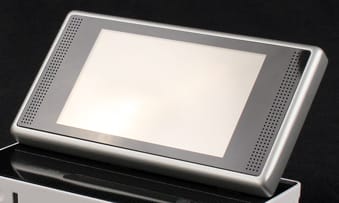
...but it turns into a nice 3-inch widescreen in playback mode.
Flash
{{section_header}}{{section.name}}{{/section_header}}
Fujifilm rates the flash for up to 14.1-feet on auto ISO. It can be set to auto, forced, off or slow-synchro. When face detection is turned on, it switches to red-eye reduction for flash mode. Flash is placed directly below the shutter/zoom controls, which means it's very easy to accidentally block. Shooting the flash against a blank wall, we were pleased by the evenness of it's coverage, and the light drop off towards the edges was minimal.
Positioned next to the flash is a small autofocus assist lamp. This white LED is very bright, and helps substantially when focusing in dark settings.

The flash emitter pops up from the top of the body via a mechanical release.
Lens
{{section_header}}{{section.name}}{{/section_header}}
The lens has 5x optical zoom, with a focal length of 6.4mm to 32mm (equivalent to a 28-140mm in 35mm photography). At the wide-angle end of the spectrum, the aperture range runs f/3.3 to f/9, at telephoto it's f/5.1 to f/14.

Battery
{{section_header}}{{section.name}}{{/section_header}}
The rechargeable Lithium ion battery is rated for 230 shots per charge. This isn't fantastic battery life, but it isn't too bad. This number feels more or less accurate, though the camera does have the annoying habit of losing its last bar of battery charge much quicker than the others.

Memory
{{section_header}}{{section.name}}{{/section_header}}
Fujifilm has done something clever with the memory card slot on this camera. While the company has long supported the increasingly antiquated xD memory card format, it has also developed a single slot which can accept either xD cards or the far more practical SD/SDHC card format. We wish Olympus (the other major user of xD cards) would adopt this solution too.

Jacks, Ports & Plugs
{{section_header}}{{section.name}}{{/section_header}}
The F200WXR has a single proprietary I/O port, from which a single cable is used for both AV and USB functions. It's a highly unusual cable, with connectors for both types of plug, and would be difficult to replace should it get lost.
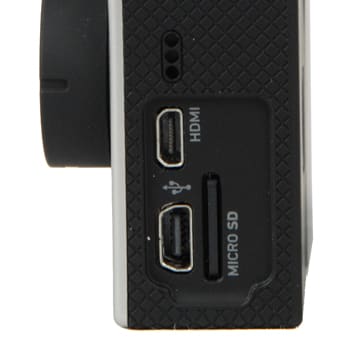
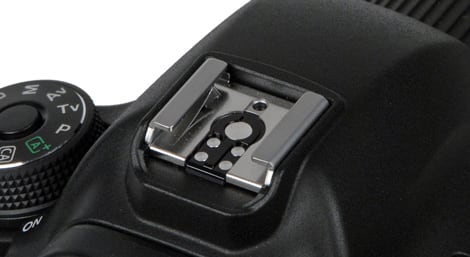
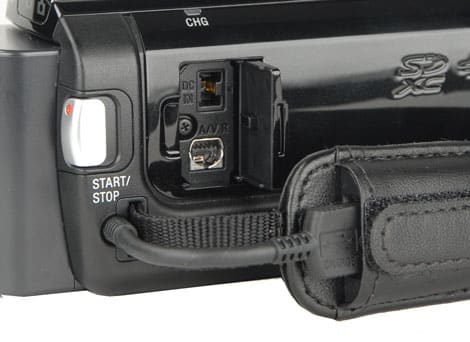
The DC-input and multi-AV port are located on the right side of the camcorder.
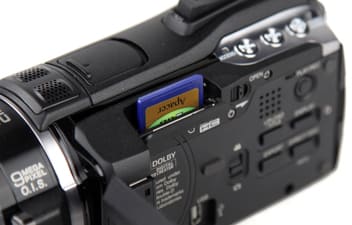
... as is the SD/SDHC card slot.
Shooting Modes
{{section_header}}{{section.name}}{{/section_header}}
The shooting modes on the F200EXR require some explanation. There are quite a few here, some of which are more complex than others.
First, there's a Manual mode, which we greatly appreciate, an it lets you set the shutter speed across the entire range of the camera, but limits the aperture to minimum or maximum. Program mode lets you access all the controls of the camera, but sets the exposure for you. Through the menu system, while the mode dial is set to Program, you can switch over to Aperture priority, but once again you can only set it to maximum or minimum.
Natural Light mode is auto mode, but with the ISO boosted and the flash suppressed. Natural and Flash mode takes two shots, one after the other, the first without flash and the second with. Auto mode removes most user control, but lets you cap the maximum ISO that it automatically selects to 3200, 1600, 800, 400; set image size and quality; film mode; image stabilization; burst; timer; macro and flash. Finally, there's EXR mode, which is the center of much of the interest in this camera. While in EXR mode, it can be set to one of four modes: EXR Auto; HR (resolution priority); SN (high ISO and low noise); and DR (D-Range priority).
High resolution EXR mode will use the camera's sensor at its maximum 12-megapixel resolution. The two other modes lower the resolution down to six megapixels, and attempt to provide image enhancement benefits. SN mode (low noise), works by 'pixel binning', or combining the information from adjacent pixels on the sensor to create slightly larger pseudo-pixels, which is supposed to produce lower noise. However, when we tested this facet, the noise improvement wasn't huge over shooting at 12-megapixels. The noise performance at 6 megapixels in Program mode was identical to what we found in EXR SN mode. We checked with Fujifilm, who confirmed that while in Program mode at 6-megapixel resolution, the camera will employ the EXR mode to produce lower noise.
DR mode works by taking two images simultaneously at slightly different exposures, using alternating pixels. This boost can be set to 100%, 200%, 400% or 800%, though if you're just shooting in Program mode, if you lower the resolution to six megapixels, you can also set it to 100%, 200% or 400%. We discuss dynamic range in greater detail below, but in brief, it's far better at bringing information out of over-exposed areas rather than the shadows.
Finally, Auto EXR mode analyzes the scene you're about to shoot, and chooses the best of the three modes.
Auto Mode Features
The focus mode can be set to one of three settings: center, which just looks at the middle of the image; multi, which tries to find the best focus area over the entire frame; and continuous, which constantly refocuses at the very center of the image, for as long as the shutter button is half-pressed. If face detection is turned on, it'll pay attention to people over any other focus mode.
Generally, focusing feels relatively speedy, even at low light levels (thanks to the bright autofocus assist lamp). Tucked away in the energy saver menu option is the ability to turn on 'quick autofocus,' which we assume uses more power than the normal mode. It seemed to speed things up marginally, but wasn't a breathtaking improvement.
The exposure compensation range of ±2 EV is a bit lower than we would have liked. The camera does not offer exposure bracketing.
On Fujifilm cameras, Metering is labeled Photometry. It has the usual set of options: Multi, Spot and Average.
Though the camera lacks a dedicated shutter priority option, the shutter speed range ( 1/1500-8 seconds) is respectable, though a maximum speed of 1/2000 would have been a worthwhile improvement.
The F200EXR has two self-timer modes, 10 second and 2 second. Unfortunately, the self-timer setting is cancelled after each shot, which which makes it a pain to repeatedly shoot using the timer.

The full mode dial is nice, but frequently rotates by accident.
Scene Modes
Scene mode has 15 presets: Portrait, Portrait Enhancer, Landscape, Sport, Night, Night (tripod), Fireworks, Sunset, Snow, Beach, Underwater, Museum, Party, Flower, and Text.
Picture Effects
{{section_header}}{{section.name}}{{/section_header}}
The F200EXR doesn't have any dedicated picture effects, but its Film Simulations work in a similar fashion. These mimic the effects of various brands of Fuji's 35mm film.
Manual Controls
{{section_header}}{{section.name}}{{/section_header}}
The F200EXR has white balance presets for sunlight, shade, daylight fluorescent, warm white fluorescent, cool white fluorescent, incandescent and underwater. There is also an auto mode, and the ability to take a custom white balance, which is often missing from compact cameras and certainly worth having.
The lens isn't particularly fast, with a maximum aperture of just f/3.3, and has a minimum of f/14.
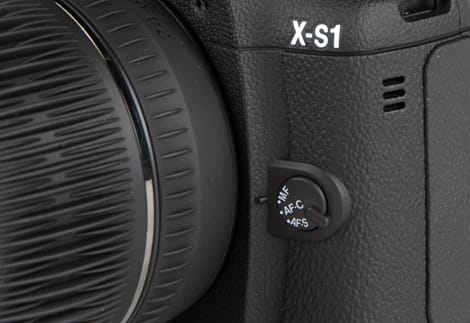
A dedicated focus-mode switch on the front panel.
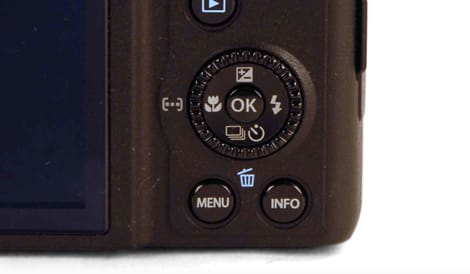
The scroll wheel surrounding the d-pad is neither awful nor perfect.
Drive/Burst Mode
{{section_header}}{{section.name}}{{/section_header}}
The F200EXR's burst mode is frustrating, and overly complex. There are three speeds: three-shot (1.4 fps at full size), 12-shot (5 fps at 3MP), or long period. 12-shot and three-shot can be set to final or top modes. In final mode, you can up to 40 photos, but only the final 12 or 3 are saved (depending on which speed you're shooting at). Top mode will take either 12 or 3 shots, then stop. Long period will continuously take photos as long as the shutter button is held, but is slower than any other mode.
Shot to Shot ({{product.raw_scores['Shot to Shot Score']}})
We tested the F200EXR in long period mode, as our testing involves shooting at the highest burst resolution, for at least five frames. Thus, both 12-shot and three-shot modes were inappropriate. In long period mode, it took 0.5 frames per second, which is very slow.
Handling
{{section_header}}{{section.name}}{{/section_header}}
The F200EXR isn't the slimmest camera on the block, but it's got a pleasant heft that makes it feel good in the hand. That said, it's a little thick for slipping into tight pockets. Since the entire body is glossy plastic, it picks up fingerprints very easily, especially the silver areas.




These dedicated buttons give you quick access to aperture and shutter speed controls.
Buttons & Dials
{{section_header}}{{section.name}}{{/section_header}}
The button layout is identical to what you see on 90% of point-and-shoot cameras, which makes it almost instantly usable if you've had one before. The buttons are a little on the small side, so if you have largish fingers, you might find using the four-way pad a bit inaccurate sometimes.


Menus
{{section_header}}{{section.name}}{{/section_header}}
The menu system runs as an overlay on top of the live view, so you can always see your images peeping through around it. While the controls are quite expansive, the menu has an annoying habit of kicking you out every time you change a setting. If you want to alter multiple settings at a time, you have to change one, go back to the menu, change another, go back to the menu, etc. It gets old very quickly.
Manual & Learning
{{section_header}}{{section.name}}{{/section_header}}
The F200EXR's manual is rather sad. It's very thin, doesn't define functions very well at all, and certainly doesn't devote enough time to the intriguing EXR modes that the camera can use. It skirts over the vast majority of content, offering only brief explanations. There is no index, and the table of contents is only a few minor steps away from being useless.
Casio Exilim EX-FC100 Comparison
These two cameras make an interesting comparison. The Fuji narrowly beats the Canon on color accuracy, and scores a bit higher on resolution. It does a little worse in terms of image noise, with significant deficits in video performance, image stabilization and continuous shooting speed. The Canon has a much better user interface and control scheme, but is lacking the manual and aperture priority modes of the F200EXR. Physically, the Canon is marginally bigger than the Fuji, but weighs slightly less. The PowerShot also has the advantage of shooting HD video in 720p format, but the F200EXR has a higher maximum ISO (though at reduced size). The Canon also has a slightly longer zoom lens (35mm equivalent of 185, compared to the F200EXR's equivalent of 140mm), but less of a wide-angle at the wide end. The decision comes down whether the Fujifilm's EXR modes are more important than the more pleasant control scheme and HD video of the Canon. Frankly, we're not sure if it is. If Fujifilm continues to work on this technology, in a few generations if may be a deciding factor, but presently the noise and dynamic range boosts aren't worth the price of admission.
Sony Cyber-shot DSC-T900 Comparison
The F200EXR and EX-FC100 are very different cameras. Each has an interesting technological hook: the Fujifilm's new sensor, and the Casio's extreme speed capabilities. In terms of image quality, the Fuji outperformed the Casio substantially in terms of color accuracy and resolution, but scored slightly lower in our image noise testing. Neither had very good image stabilization, and while the video from the Casio was better, it was by no means fantastic. The Fuji also has a much deeper control system, including a manual mode. The EX-FC100 only has a nine-megapixel sensor, compared to the F200EXR's 12, but in terms of print size, that's not a huge difference. The Casio is almost the same size as the Fuji, bust slimmer around the grip, and noticeably lighter.
The Casio's speed-demon shooting abilities are what put it beyond the Fujifilm. It can take still photographs at speeds up to 30 frames per second (though at reduced resolution), which is great for grabbing that perfectly timed shot. It can also record videos at up to 1000fps (at 224x64, a tiny sliver of content) 420fps at 224x168, and from 30 to 210fps at 480x360. These slow motion modes are not only incredibly fun to play with, but the 480x360 mode actually produces a video that's large enough to be useful,
If you want a camera that's an utter speed demon, the Casio is uniquely appealing. It's ideal for nature or sports photography. However, in terms of pure image quality and control, the Fuji is the superior camera.
COMP 3
The Sony T900 is designed to be the sexiest camera on the block, and many of its features are aesthetically pleasing, if not always sensible. It's remarkably slender, only 0.66 inches thick, to the Fujifilm's 0.9 inches. It has a touch-screen based interface, and a gorgeous, 920,000-dot LCD. The lens is tiny, and tucked away in the upper right corner, where it doesn't extend at all. The T900 is also lacking in many features, including manual controls and custom white balance, and suffers from a laggy touch-screen. It does have a better range of full resolution ISOs, but can't get near the ISO 12,800 at reduced size that the Fujifilm offers.
In terms of performance, the Sony surpassed the Fuji for color accuracy, image stabilization, movie quality, and shot to shot speed. On the flip side, the Fuji had much lower image noise, as well as significantly better resolution. This was in part due to the small lens on the Sony, which had significant chromatic aberration and distortion problems, and a tendency to digitally oversharpen images too much.
The Sony feels more like a camera that you would want to be seen with. It's stylish, sleek, but ultimately feels shallow. The interface is annoying, it lacks manual controls, and its lens isn't what anyone would consider high-performance glass. If you want a sliver of a camera that will draw a bit of a crowd, and takes decent photos, the Sony won't let you down. The Fujifilm, on the other hand, offers more control, and generally better image quality.
Conclusion
The Fujifilm FinePix F200EXR is a camera that offers a tantalizing hint at a possible future technology. The new EXR sensor has the potential to be very useful, as many current cameras keep adding megapixels to the detriment of image quality. The ability to increase noise performance or dynamic range, even at the expense of a lower resolution setting, is a fantastic one, but it's a shame it doesn't do more right now. The noise advantage in low noise mode isn't huge, and the dynamic-range boost helps a little, but only in over-exposed areas. This is a technology that we feel may improve significantly over the next few generations of camera, and might some day become a deciding factor in a purchase. However, at present, it doesn't work well enough to justify the $400 sticker price.
That's not to say it's a bad camera, which it isn't at all. The resolution and color performance were both very good, and the noise levels are decent too. It has plenty of controls, including a manual mode lacking in similarly-priced models, and we were generally pleased with how it performed. However, the menu interface is set up poorly, the video mode is limited to 640x480, and the shot to shot speed was a letdown. It's a decent camera that takes good pictures, but for $400 there are a lot of alternatives out there.
Photo Gallery
{{photo_gallery "Front Photo", "Back Photo", "Sides Photo", "Top Photo", "Bottom Photo", "Lens Photo", "Flash Photo", "EVF Photo 1", "EVF Photo 2", "LCD Photo 1", "LCD Photo 2", "Media Photo", "Modes Photo", "Manual Controls Photo", "Manual Controls Photo 2", "Other Controls", "Buttons 1", "Buttons 2", "Other Hardware Photo", "Battery Photo", "Ports Photo 1", "Ports Photo 2", "Ports Photo 3", "Ports Photo 4", "Handling Photo 1", "Handling Photo 2", "Handling Photo 3", "Box Photo"}}
Meet the tester
Tim Barribeau is a valued contributor to the Reviewed.com family of sites.
Checking our work.
Our team is here to help you buy the best stuff and love what you own. Our writers, editors, and experts obsess over the products we cover to make sure you're confident and satisfied. Have a different opinion about something we recommend? Email us and we'll compare notes.
Shoot us an email